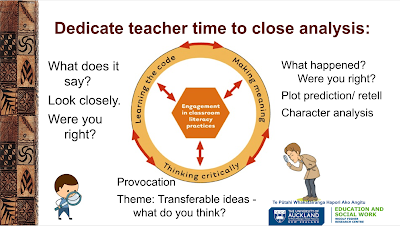To learn about the world, words - you need to read widely. Wide reading is also one of the key ways that learners develop word knowledge and world knowledge. This includes multimodal texts.
Practice makes perfect, more practise getting better.
- Shared reading: Big Book reading, re-read it with a different focus on each day. Word knowledge, world knowledge, practice
- Buddy reading: Practice, endurance, resilience
- Independent reading: (eg publishing, book box reading, reading the room, poetry, books, learning centres etc .. )
How can we read deepen:
- text sets that complement, contradict that, building understanding over time. 4 different types of text related to the topic.
Part 1: Ways of getting the themes from the books:
1. Look for the big idea (abstract)
2. Look for what the main character learns
3. Look for change over time in the book.
Who is the main character?
a) Who changes most? b) Who learns most? c)Sidekicks - what are their roles? d)What is the relationship?
Transferring our knowledge to new experiences: let's think about how the character uses what they learn: *how a lesson is taught and applied. *The in-joke between characters who shared an experience. *What characters know about.
Likeable and unlikeable characters How does a text create characters that we like? don't like it?
Synthesis treats them like a set. Higher-order thinking skills require people to bring knowledge from different
=> Next 'Stuck for a provocation? GO to NZ
Come to the text, thinking - "thought" & cause "provoked" them. It's about ideas & critical thinking.
When introducing the text: it's about the 'big idea'.
=> Go back to your modelling book. Word walls/Word cards/image match etc can't need
=> Did I do this?
1. Look closely at selected passages
2. Carefully choose the important bits to 'get'
3. Analyse passages
4. Build English content knowledge
5. Insist on textual evidence



No comments:
Post a Comment